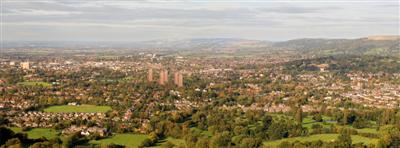Our better nature's buried in the rubble........
(lyrics from 'Business as Usual' by Don Henley)
 ©Cotswold ImagesImposing they may have been; today we are justified in asking if Cheltenham was ever the kind of town in which mega-structures like this should even have been considered, never mind imposed.
©Cotswold ImagesImposing they may have been; today we are justified in asking if Cheltenham was ever the kind of town in which mega-structures like this should even have been considered, never mind imposed.
Fortunately Cheltenham entered the third millennia a predominatly low-rise attractive town, and not as things could have looked had this photographic impression of 1960s plans become reality. From this uniquely attractive viewpoint on Charlton Kings Common, (part of the Cotswold escarpment) the outlook across the town and Severn Vale has been enjoyed for centuries. The foreground remains the jewel in the crown as it continues to host most of the Georgian and Regency architecture Cheltenham is still renowned for. Beyond the town is the famous Prestbury Park Racecourse, overlooked by Cleeve Hill, (its own lengthy history including the Iron Age hill-fort of two thousand years ago and the venue for Cheltenham's first Gold Cup flat race in 1819). Beyond this is Nottingham Hill, Oxenton Hill, Tewkesbury, the River Severn (Britain's longest river) and some of the prettiest villages to be seen in the country, spread out neatly across the vale towards its much older Malvern Hills backdrop.
Following in the footsteps of Dr Johnson in 1749, thousands of people have admired these locations from both wold and vale. Today the escarpment forms part of the internationally popular 'Cotswold Way' hiking route (Chipping Campden to Bath) as well as local walks, where this relatively unspoilt panoramic vista is seen by countless walkers and photographers. As a National Trail located within Britain's second largest protected area - or Area of Oustanding Natural Beauty (AONB) it is necessary for all who care about such things to look after the 'bigger picture', as we see it today - especially if we want future generations to do so.
Thankfully, down in Charlton Park, a more subtle range of dwellings sit amongst the trees, forming an acceptable mix of brick and branch, people and parkland. The contrast between 1960s and 1970s plans could hardly have been greater and we are fortunate the earlier ones never reached a site agent's hands, potentially blighting this beautiful view for unknown decades to come.
Consequently, most of us remain extremely proud of what we still have here in the Cotswolds and cherish our local heritage. But if history is to teach us anything, in Cheltenham it ought to teach us that nothing is taken for granted. Although many lessons may have flowed from hallowed-halls nearby, such lessons have not always benefitted the local populace or resulted in the avoidance of mistakes, whether by destruction or construction. People living here today are advised to keep a weather-eye on the local scene, especially those who revere it so from the Cotswold Hills, where the impact of unlearnt, or skipped lessons, is occasionally seen writ large on the landscape below.
